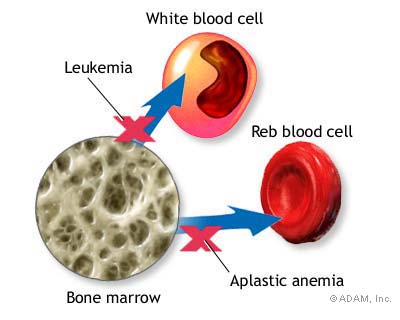
Aplastic anemia is a condition where bone marrow does not produce sufficient new cells to replenish blood cells.
The term 'aplastic' means the marrow suffers from an aplasia that renders it unable to function properly. Anemia is the condition of having reduced hemoglobin or red cell concentration in the blood. Typically, anemia refers to low red blood cell counts, but aplastic anemia patients have lower counts of all three blood cell types: red blood cells, white blood cells, and platelets, termed pancytopenia.
Causes
One known cause is an autoimmune disorder, where the white blood cells attack the bone marrow.
In many cases, the etiology is impossible to determine, but aplastic anemia is sometimes associated with exposure to substances such as benzene, radiation, or to the use of certain drugs, including chloramphenicol, carbamazepine, felbamate, phenytoin, quinine, and phenylbutazone. Many drugs are associated with aplasia mainly in the base of case reports but at a very low probability, As an example, chloramphenicol treatment is followed by aplasia in less than 1 in 40,000 treatment courses, and carbamazepine aplasia is even more rare.
Aplastic anemia is present in up to 2% of patients with acute viral hepatitis.
In some animals aplastic anemia may have other causes. For example, in the ferret (mustela putorious furo) aplastic anemia is caused by estrogen toxicity. This is because female ferrets are induced ovulators, so mating is required to bring the female out of heat. Unneutered females, if not mated, will remain in heat, and after some time the high levels of estrogen will cause the bone marrow to stop producing red blood cells.
Signs and symptoms
- Anemia with malaise, pallor and associated symptoms such as palpitations
- Thrombocytopenia (low platelet counts), leading to increased risk of hemorrhage, bruising and petechiae
- Leukopenia (low white blood cell count), leading to increased risk of infection
Diagnosis
The condition needs to be differentiated from pure red cell aplasia. In aplastic anemia the patient has pancytopenia (i.e., anemia, neutropenia and thrombocytopenia) resulting in decrease of all formed elements. In contrast, pure red cell aplasia is characterized by reduction in red cells only. The diagnosis can only be confirmed on bone marrow examination. Before this procedure is undertaken, a patient will generally have had other blood tests to find diagnostic clues, including a complete blood count (CBC), renal function and electrolytes, liver enzymes, thyroid function tests, vitamin B12 and folic acid levels.
Treatment
Treating immune-mediated aplastic anemia involves suppression of the immune system, an effect achieved by daily medicine intake, or, in more severe cases, a bone marrow transplant, a potential cure but a risky procedure.[2] The transplanted bone marrow replaces the failing bone marrow cells with new ones from a matching donor. The pluripotent stem cells in the bone marrow reconstitute all three blood cell lines, giving the patient a new immune system, red blood cells, and platelets. However, besides the risk of graft failure, there is also a risk that the newly created white blood cells may attack the rest of the body ("graft-versus-host disease").
Medical therapy of aplastic anemia often includes a short course of anti-thymocyte globulin (ATG) or anti-lymphocyte globulin (ALG) and several months of treatment with cyclosporin to modulate the immune system. Mild chemotherapy with agents such as cyclophosphamide and vincristine may also be effective. Antibodies therapy, such as ATG, targets T-cells, which are believed to attack the bone marrow. Steroids are generally ineffective.
In the past, before the above treatments became available, patients with low leukocyte counts were often confined to a sterile room or bubble (to reduce risk of infections), as in the famed case of Ted DeVita.